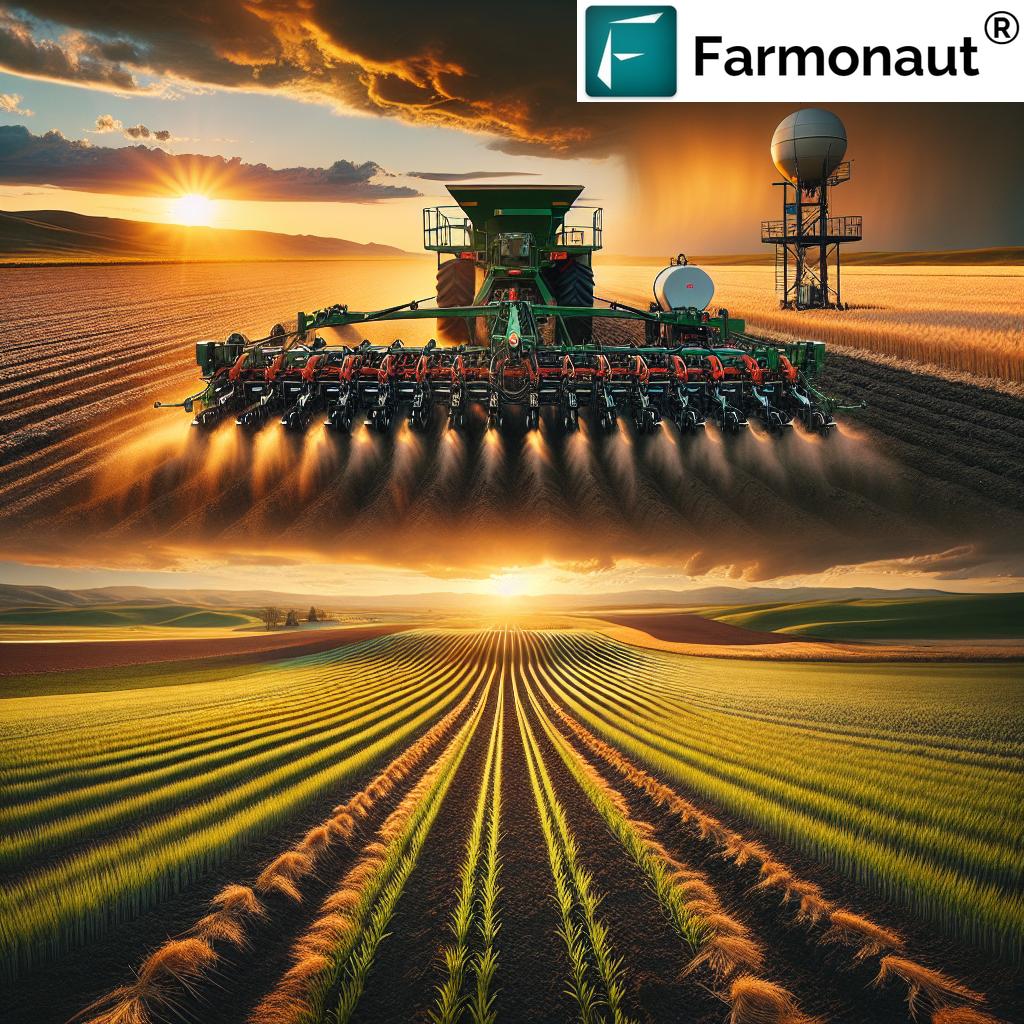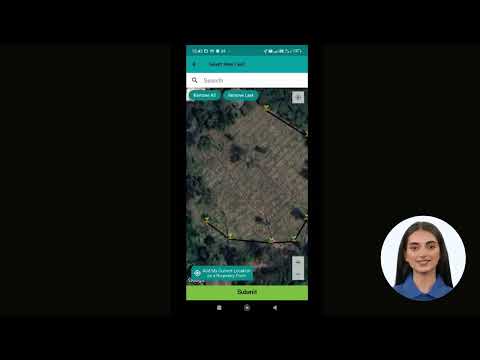Mastering Fall Seeding: Innovative Techniques for Winter Wheat and Rye in Montana’s Changing Climate
As we approach the fall season in Montana, our team at Farmonaut is excited to share innovative techniques for winter wheat and rye seeding. In this comprehensive guide, we’ll explore how farmers can adapt to Montana’s changing climate while optimizing their fall seeding practices. Our focus on sustainable farming practices in the Midwest will help producers navigate the challenges of seasonal transitions and prepare for a successful winter crop.

“Winter wheat planted in Montana can survive temperatures as low as -20°F (-29°C) when properly established.”
The Importance of Fall Seeding in Montana
Fall seeding is a crucial practice for farmers in Montana and throughout the Midwest. As the summer harvest comes to an end, it’s time to prepare for the next growing season. Winter wheat and rye are two popular crops that thrive when planted in the fall, providing numerous benefits for both the soil and the farmer’s bottom line.
In the United States, particularly in states like Montana, Kansas, and Missouri, fall seeding has become an essential part of crop rotation strategies. This practice not only helps in managing soil health but also plays a significant role in sustainable farming practices.
Understanding Montana’s Changing Climate
Before we delve into specific fall seeding techniques, it’s crucial to understand the impact of Montana’s changing climate on agriculture. As weather patterns shift, farmers must adapt their practices to ensure successful crop yields.
- Longer growing seasons
- Increased frequency of extreme weather events
- Changes in precipitation patterns
- Rising average temperatures
These climate changes present both challenges and opportunities for farmers in Montana and across the Midwest. By leveraging innovative techniques and technology, we can turn these challenges into advantages for fall seeding.
Innovative Fall Seeding Techniques for Winter Wheat
Winter wheat is a staple crop in Montana and many other states across the Midwest. Its ability to withstand cold temperatures makes it an ideal choice for fall seeding. Here are some innovative techniques to optimize your winter wheat planting:
1. Precision Planting with GPS Technology
Utilizing GPS-guided equipment for planting ensures accurate seed placement and optimal spacing. This technology allows for:
- Reduced seed waste
- Improved germination rates
- More efficient use of field space
At Farmonaut, we offer satellite-based farm management solutions that can integrate with your GPS planting equipment, providing real-time data to optimize your seeding process.
2. Variable Rate Seeding
This technique involves adjusting seed rates based on soil conditions, topography, and historical yield data. By using variable rate seeding, farmers can:
- Optimize plant populations across different field zones
- Improve overall crop uniformity
- Maximize yield potential in high-performing areas
3. No-Till Seeding for Soil Conservation
No-till seeding is gaining popularity among farmers in Montana and other Midwest states. This method offers several benefits:
- Reduced soil erosion
- Improved soil moisture retention
- Enhanced soil structure and organic matter content
By minimizing soil disturbance, no-till seeding helps preserve beneficial microorganisms and promotes overall soil health.
Rye as a Cover Crop: Enhancing Soil Health
Rye is an excellent choice for cover cropping in Montana’s changing climate. Its fast growth and extensive root system provide numerous benefits for soil health and future crop success.
“Rye cover crops can reduce soil erosion by up to 95% compared to bare fallow fields in Midwest winters.”
Key Benefits of Rye Cover Crops:
- Exceptional erosion control
- Improved soil structure
- Weed suppression
- Nutrient capture and recycling
Incorporating rye as a cover crop in your fall seeding rotation can significantly enhance the sustainability of your farming operation.
Soil Moisture Management for Successful Fall Seeding
Proper soil moisture management is crucial for successful fall seeding, especially in Montana’s semi-arid climate. Here are some innovative techniques to optimize soil moisture:
1. Subsurface Drip Irrigation
Subsurface drip irrigation systems offer precise water delivery directly to the root zone. Benefits include:
- Reduced water evaporation
- Improved water use efficiency
- Minimized weed growth
2. Soil Moisture Sensors
Implementing soil moisture sensors across your fields can provide real-time data on soil moisture levels. This information allows for:
- Targeted irrigation decisions
- Prevention of over- or under-watering
- Optimal seed germination conditions
Farmonaut’s satellite-based crop monitoring system can integrate with soil moisture sensors, providing comprehensive data for informed decision-making.
3. Conservation Tillage Practices
Implementing conservation tillage practices can help retain soil moisture and improve overall soil health. These practices include:
- Strip-tillage
- Ridge-tillage
- Mulch-tillage
By minimizing soil disturbance, these techniques help preserve soil structure and reduce moisture loss through evaporation.
Weather Impact on Agriculture: Preparing for Unpredictability
Understanding and adapting to weather patterns is crucial for successful fall seeding. In Montana’s changing climate, farmers must be prepared for increased variability and extreme weather events.
Leveraging Weather Forecasting Technology
Advanced weather forecasting tools can provide farmers with valuable insights for planning their fall seeding operations. At Farmonaut, we offer:
- Short-term and long-term weather forecasts
- Historical weather data analysis
- Crop-specific weather advisories
By integrating these forecasts with our satellite-based crop monitoring system, farmers can make data-driven decisions about the optimal timing for fall seeding.
Climate-Resilient Crop Varieties
Selecting climate-resilient varieties of winter wheat and rye is essential for adapting to Montana’s changing weather patterns. Look for varieties that offer:
- Improved drought tolerance
- Better resistance to extreme temperatures
- Enhanced disease resistance
Consult with local agricultural extension offices or seed suppliers to identify the best varieties for your specific region and climate conditions.
Crop Rotation Strategies for Sustainable Farming
Implementing effective crop rotation strategies is crucial for maintaining soil health and maximizing yields in Montana’s changing climate. Here’s how to integrate winter wheat and rye into your rotation plan:
1. Diversify Your Rotation
Include a variety of crops in your rotation to:
- Break pest and disease cycles
- Improve soil structure
- Enhance nutrient cycling
2. Consider Nitrogen Fixation
Incorporate legumes into your rotation before planting winter wheat or rye to:
- Increase soil nitrogen levels naturally
- Reduce fertilizer costs
- Improve overall soil fertility
3. Plan for Residue Management
When rotating between different crops, consider how you’ll manage crop residues to:
- Maintain soil organic matter
- Prevent nutrient tie-up
- Optimize seedbed conditions for the next crop
Winter Farming Preparation: Beyond Seeding
Successful fall seeding is just the first step in preparing for winter farming. Here are additional considerations to ensure your operation is ready for the cold months ahead:
1. Equipment Maintenance
Proper equipment maintenance is crucial for efficient fall seeding and winter operations. Be sure to:
- Service all machinery before the seeding season
- Calibrate seeders and other planting equipment
- Prepare snow removal equipment for winter use
2. Soil Testing and Amendments
Conduct thorough soil tests before fall seeding to:
- Identify nutrient deficiencies
- Determine pH levels
- Plan for appropriate soil amendments
Farmonaut’s satellite-based soil analysis can complement traditional soil testing methods, providing a comprehensive view of your field’s health.
3. Winter Protection for Perennial Crops
If you have perennial crops on your farm, take steps to protect them from winter damage:
- Apply mulch to insulate root systems
- Prune and protect vulnerable plants
- Consider using row covers or hoop houses for sensitive crops
Leveraging Technology for Optimal Fall Seeding
In today’s rapidly evolving agricultural landscape, technology plays a crucial role in optimizing fall seeding practices. At Farmonaut, we offer a range of tools to help farmers make data-driven decisions:
1. Satellite-Based Crop Monitoring
Our advanced satellite imagery provides:
- Real-time vegetation health indices (NDVI)
- Early detection of crop stress
- Historical field performance data
This information can help you identify optimal areas for fall seeding and monitor crop establishment throughout the season.
2. AI-Powered Crop Advisory
Our Jeevn AI system offers personalized recommendations for:
- Seeding dates based on local climate data
- Variety selection for your specific field conditions
- Fertilizer and irrigation scheduling
3. Precision Agriculture Integration
Farmonaut’s platform can integrate with your existing precision agriculture tools, including:
- Variable rate seeders
- GPS-guided equipment
- Soil moisture sensors
This integration allows for seamless data flow and more efficient farm management.
Explore Farmonaut’s API for advanced integration options
Comparative Analysis: Winter Wheat vs. Rye Cover Crops
To help you make informed decisions about your fall seeding strategy, we’ve prepared a comparative analysis of winter wheat and rye as cover crops. This table highlights key characteristics and benefits of each crop:
| Characteristic | Winter Wheat | Rye |
|---|---|---|
| Root Depth | Moderate (3-5 feet) | Deep (5-8 feet) |
| Cold Tolerance | High (-20°F when established) | Very High (-30°F) |
| Erosion Control | Good | Excellent |
| Nitrogen Fixation | Low | Moderate |
| Optimal Planting Window (Montana) | Sept 1 – Oct 10 | Aug 15 – Sept 15 |
| Expected Yield (bu/acre) | 40-60 | 30-50 (as grain) |
| Drought Resistance | Moderate | High |
| Flood Tolerance | Low | Moderate |
| Equipment Requirements | Standard grain drill | Standard grain drill or broadcast seeder |
| Precision Farming Compatibility | High | High |
This comparison illustrates that both winter wheat and rye have unique strengths as fall-seeded crops. The choice between them will depend on your specific farm goals, soil conditions, and climate considerations.
Agricultural Weather Forecasts: Planning for Success
Accurate weather forecasting is essential for successful fall seeding and winter crop management. At Farmonaut, we provide comprehensive agricultural weather forecasts to help farmers make informed decisions.
Short-Term Forecasts
Our short-term forecasts offer:
- Hourly and daily precipitation predictions
- Temperature highs and lows
- Wind speed and direction
- Soil temperature estimates
These forecasts are crucial for timing your fall seeding operations and ensuring optimal conditions for seed germination.
Long-Term Seasonal Outlooks
Our long-term seasonal outlooks provide:
- Monthly temperature and precipitation trends
- Drought probability assessments
- Frost date predictions
These outlooks can help you plan your crop rotation strategies and make informed decisions about variety selection.
Climate Change Projections
To help farmers adapt to Montana’s changing climate, we also offer:
- Long-term climate trend analysis
- Projections for shifts in growing seasons
- Recommendations for climate-resilient farming practices
By leveraging these forecasts and projections, farmers can better prepare for the challenges and opportunities presented by climate change in Montana and the broader Midwest region.
Farm Management Tips for Fall Seeding Success
Effective farm management is crucial for successful fall seeding. Here are some key tips to optimize your operations:
1. Record Keeping and Data Analysis
Maintain detailed records of your fall seeding practices, including:
- Seeding dates and rates
- Variety performance
- Weather conditions during planting
- Yield data from previous seasons
Analyzing this data can help you refine your practices year after year. Farmonaut’s platform offers tools for easy data collection and analysis.
2. Workforce Management
Ensure your team is prepared for the fall seeding season:
- Provide training on new equipment or techniques
- Schedule labor efficiently to meet seeding windows
- Implement safety protocols for fall and winter work
3. Financial Planning
Develop a solid financial plan for your fall seeding operations:
- Budget for seed, fertilizer, and equipment costs
- Explore crop insurance options for winter wheat
- Consider government programs or subsidies for cover cropping
4. Sustainability Initiatives
Implement sustainable practices in your fall seeding strategy:
- Minimize tillage to reduce soil erosion
- Use precision agriculture tools to optimize input use
- Consider participating in carbon credit programs
Farmonaut’s carbon footprinting tools can help you track and improve your farm’s environmental impact.
Preparing for the Future: Adapting to Climate Change in Montana
As we look to the future of agriculture in Montana, it’s clear that adapting to climate change will be crucial for long-term success. Here are some strategies to consider:
1. Diversification
Consider diversifying your crop portfolio to spread risk:
- Explore new crop varieties suited to changing conditions
- Integrate livestock or agroforestry practices
- Develop value-added products from your crops
2. Water Management
Implement advanced water management techniques:
- Invest in efficient irrigation systems
- Explore water harvesting and storage options
- Adopt drought-resistant crop varieties
3. Soil Health Focus
Prioritize soil health to build resilience:
- Implement year-round cover cropping
- Minimize soil disturbance
- Increase organic matter through compost and manure applications
4. Technology Adoption
Embrace new technologies to optimize farm management:
- Utilize precision agriculture tools for targeted inputs
- Implement IoT devices for real-time monitoring
- Explore AI and machine learning for predictive analytics
Farmonaut’s suite of digital farming tools can help you stay at the forefront of agricultural technology.
Conclusion: Embracing Innovation for Sustainable Fall Seeding
As we navigate the challenges of fall seeding in Montana’s changing climate, it’s clear that innovation and adaptation are key to success. By embracing new technologies, implementing sustainable practices, and staying informed about weather patterns and climate trends, farmers can optimize their fall seeding operations for both winter wheat and rye.
At Farmonaut, we’re committed to supporting farmers with cutting-edge tools and data-driven insights. Our satellite-based crop monitoring, AI-powered advisory systems, and comprehensive weather forecasts can help you make informed decisions and achieve better yields while promoting sustainable farming practices.
As you prepare for this fall’s seeding season, we encourage you to explore the resources and tools available through Farmonaut. Together, we can build a more resilient and productive agricultural future for Montana and beyond.
Explore Farmonaut’s API Developer Docs for advanced integration options
Frequently Asked Questions (FAQ)
- What is the best time to plant winter wheat in Montana?
The optimal planting window for winter wheat in Montana typically falls between September 1 and October 10, depending on your specific location within the state. - How does rye compare to winter wheat as a cover crop?
Rye generally provides better erosion control and has deeper roots than winter wheat. It’s also more cold-tolerant and can be planted earlier. However, winter wheat often produces higher grain yields if that’s a consideration. - What are the benefits of using precision agriculture for fall seeding?
Precision agriculture tools can help optimize seed placement, reduce input costs, improve germination rates, and increase overall yield potential by tailoring seeding practices to specific field conditions. - How can Farmonaut’s satellite monitoring help with fall seeding?
Farmonaut’s satellite monitoring provides real-time crop health data, soil moisture information, and historical field performance analytics. This can help farmers identify optimal areas for seeding and monitor crop establishment throughout the season. - What steps can I take to improve soil moisture retention for fall-seeded crops?
Implementing conservation tillage practices, using cover crops, adding organic matter to the soil, and optimizing irrigation systems can all help improve soil moisture retention for fall-seeded crops.







